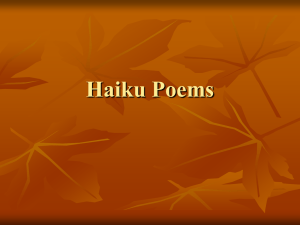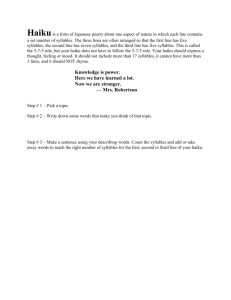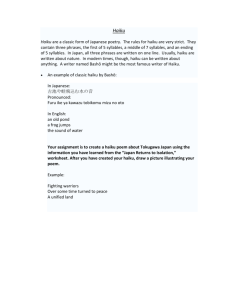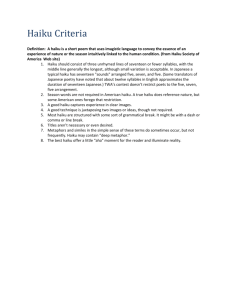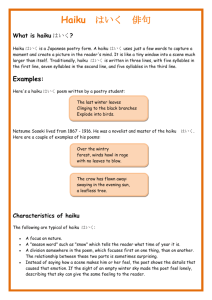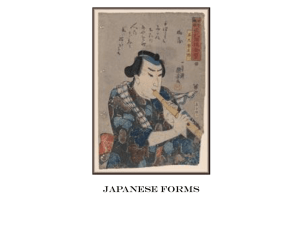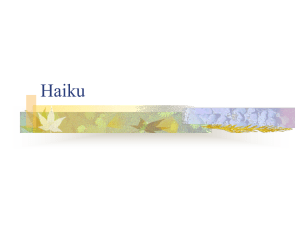Haiku Poetry: Definition, Structure, and Examples
advertisement
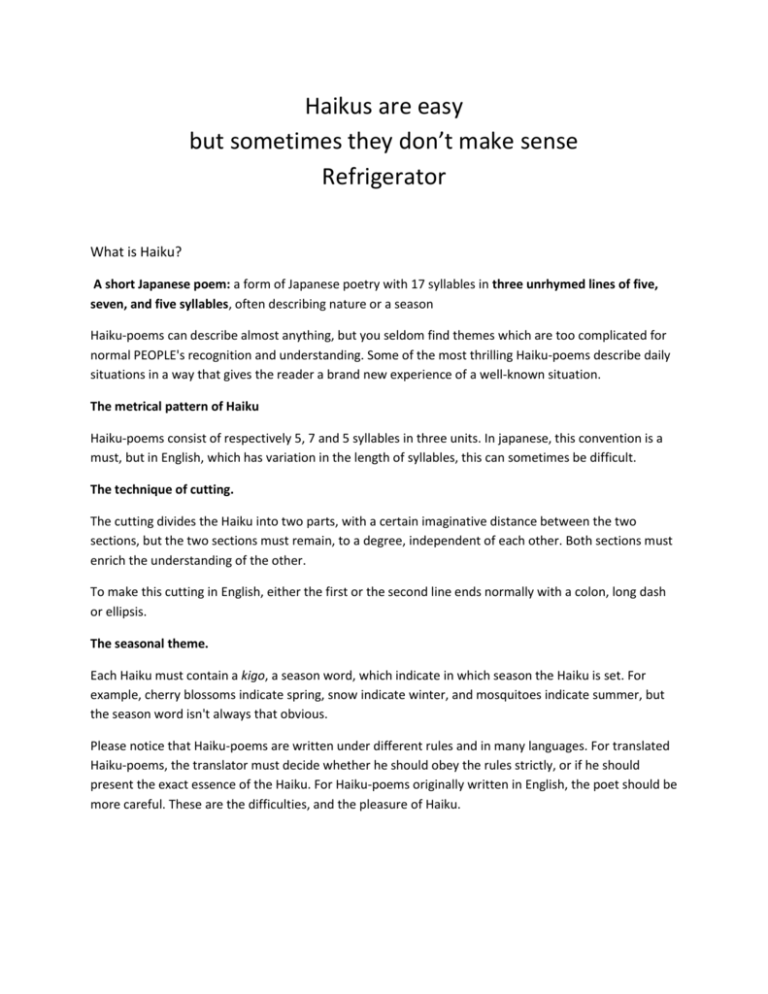
Haikus are easy but sometimes they don’t make sense Refrigerator What is Haiku? A short Japanese poem: a form of Japanese poetry with 17 syllables in three unrhymed lines of five, seven, and five syllables, often describing nature or a season Haiku-poems can describe almost anything, but you seldom find themes which are too complicated for normal PEOPLE's recognition and understanding. Some of the most thrilling Haiku-poems describe daily situations in a way that gives the reader a brand new experience of a well-known situation. The metrical pattern of Haiku Haiku-poems consist of respectively 5, 7 and 5 syllables in three units. In japanese, this convention is a must, but in English, which has variation in the length of syllables, this can sometimes be difficult. The technique of cutting. The cutting divides the Haiku into two parts, with a certain imaginative distance between the two sections, but the two sections must remain, to a degree, independent of each other. Both sections must enrich the understanding of the other. To make this cutting in English, either the first or the second line ends normally with a colon, long dash or ellipsis. The seasonal theme. Each Haiku must contain a kigo, a season word, which indicate in which season the Haiku is set. For example, cherry blossoms indicate spring, snow indicate winter, and mosquitoes indicate summer, but the season word isn't always that obvious. Please notice that Haiku-poems are written under different rules and in many languages. For translated Haiku-poems, the translator must decide whether he should obey the rules strictly, or if he should present the exact essence of the Haiku. For Haiku-poems originally written in English, the poet should be more careful. These are the difficulties, and the pleasure of Haiku. One of the pioneers of this Japanese poetic form was a man named Basho, Matsuo. (1644-1694). You will notice that the syllables to the following poems do not necessarily follow the 5 -7- 5 pattern because they are translations. You may also notice that there are rhyming couplets in many of them. This is not typical of most haiku. Read the following haiku by Basho and beside each, write the season in which you believe it was written. What clues lead you to your conclusion? The first soft snow! Enough to bend the leaves Of the jonquil low. In the cicada's cry No sign can foretell How soon it must die. No one travels Along this way but I, This autumn evening. In all the rains of May there is one thing not hidden the bridge at Seta Bay. The years first day thoughts and loneliness; the autumn dusk is here. Clouds appear and bring to men a chance to rest from looking at the moon. Harvest moon: around the pond I wander and the night is gone. Poverty's child he starts to grind the rice, and gazes at the moon. In Japanese, the 17 syllable pattern is strictly followed when writing haiku. In English, it is not so important, as we do not share the same phonetic system as the Japanese. It is more important that we maintain the essence of haiku: Can be uttered in one exhalation 3 Line form Simple yet profound Uses imagery – the descriptive power of words In the garden pool dark and still, a stepping stone releases the moon. Clouds sit still above. Mountains stir a placid sea. Nature's beauty glows Your turn to write haiku Try structuring your haiku like this: Line 1 - 5 Syllables describing the object “Slow dancing raindrops” Line 2- 7 Syllables describing an action or more about the object or idea “Rolling down the window sill” Line 3- 5 Syllables as a concluding thought for the poem “Calming, nourishing.” 1. Experiment with this form. Try different combinations of syllables (eg. 3 – 4 – 3) 2. Write a few haiku on the subject of your choice. Try using this as a model: Adjective adjective noun verb Adjective noun verb and Verb the adjective adjective noun. It is time to create your own set of haiku. You will spend your time writing a serious of haiku relating to one theme or subject. An example would be love, or the seasons, or the passage of time. Try to be as creative and profound as possible. You will write 4 to 6 haiku in this series.
